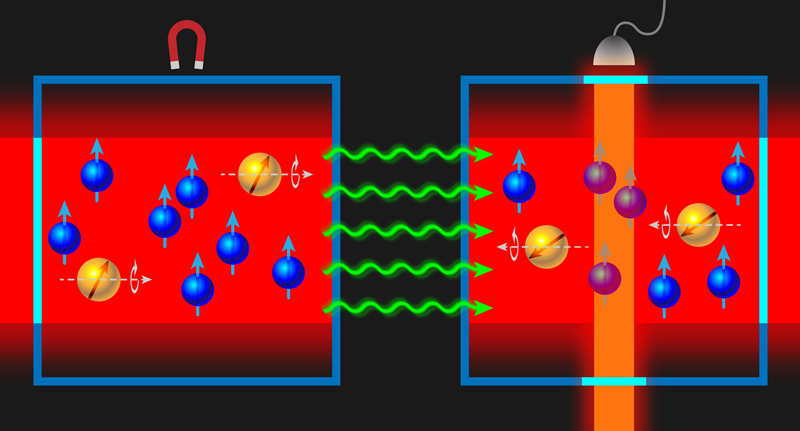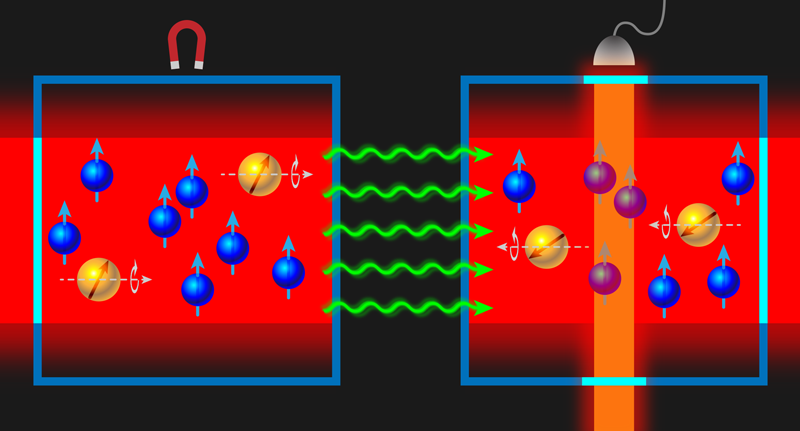Searching for Axions in Polarized Gas
The standard model of fundamental particles and interactions has now been in place for about a half-century. It has successfully passed experimental test after experimental test at particle accelerators. However, many of the model’s features are poorly understood, and it is now clear that standard-model particles only compose about 5% of the observed energy density of the Universe. This situation naturally encourages researchers to look for new particles and interactions that fall outside this model. One way to perform this search is to prepare a gas of polarized atoms and to look for changes in this polarization that might come from new physics. Haowen Su from the University of Science and Technology of China and colleagues have used two separated samples of polarized xenon gas to probe spin-dependent interactions [1] (Fig. 1). The results place constraints on axions—a candidate for dark matter—in a theoretically favored mass range called the axion window.
Searches for new spin-dependent interactions have exploded over the past decade. Special relativity and quantum mechanics tightly constrain the mathematical form for such interactions, with the main adjustable parameters being the coupling strength and the spatial range. Since the form of these interactions is generic across many models, it is possible to conduct experimental searches for new interaction signatures, even in the absence of a specific theory for beyond-standard-model physics.
One possible type of spin-dependent interaction is that mediated by the axion, a very light (but not massless) particle that could make up some of the missing dark matter in the Universe. The axion was originally proposed as a way to address a particle-physics mystery: the apparent absence of time-reversal violation in the strong interaction [2]. The axion model does not specify the mass of this hypothetical particle, but the simplest version of the theory proposes the mass of the axion is most likely in the range between 10 µeV/c2 and 1 meV/c2, which is referred to as the axion window [3–5].
Using a variety of tools (from microwave cavities to radio telescopes), researchers have searched for observational signatures of axions over a large range of masses—often outside the axion window. One way to look for axions is to study spin-dependent effects that resemble magnetic-field interactions. The advantage of this strategy is that experiments can now probe small spin-dependent effects with extremely high sensitivity. This sensitivity arises from well-understood quantum interference effects of few-state spin systems and also from the avalanche of new ideas and techniques coming from developments in quantum information and quantum sensing.
Su and colleagues have designed their experiment to take advantage of this spin-based technology to probe spin-dependent interactions mediated by axions in a mass range that includes the axion window [1]. Specifically, the researchers searched for axion interactions with xenon-129 (129Xe) atoms that were polarized through spin-exchange optical pumping [6]. This well-established method involves mixing the 129Xe atoms with rubidium-87 (87Rb) atoms and exposing the mixture to circularly polarized light. The light polarizes the outer electrons of the rubidium atoms, but it has no effect on the closed-shell electrons surrounding the xenon atoms. However, the optically pumped rubidium atoms act as a spin-angular-momentum reservoir that slowly but surely polarizes the spin-1/2 nuclei of the 129Xe atoms through atomic collisions, thereby creating an interacting ensemble of atoms with electronic and nuclear polarizations. The closed electron shell of xenon isolates its polarized nucleus from external perturbations well enough to preserve its polarization over the required measurement time.
The team utilized two cells of polarized 87Rb–129Xe ensembles separated by a distance of 60 mm. A magnetic-field pulse applied to one cell (called the source) caused the spins of the xenon atoms to tilt by 90° and precess around their polarization axis at an atom-specific rate called the Larmor frequency. This precession of the xenon atoms’ magnetic moments generated an outgoing signal associated with the normal magnetic-field interaction. But the precession can potentially generate a second signal from the exotic spin-dependent interaction of interest. Both of these signals can influence the spin polarization of the atoms in the second cell (called the sensor), but the researchers surrounded both cells with shielding that largely suppressed the effect from the normal magnetic-field interaction. Using a laser probe, they monitored the polarization of the atoms in the sensor cell, looking for possible deviations that might reveal the presence of the exotic interaction.
Polarized 87Rb–129Xe ensembles have been created and used by many researchers for several purposes, including searches for spin-dependent interactions. The work of Su and colleagues is distinguished by their application of two new developments—magnetic amplification and signal templates—which enabled them to improve the sensitivity of their search for spin-dependent exotic interactions by about 2 orders of magnitude beyond the existing state of the art. The magnetic amplification comes from the resonance condition at xenon’s Larmor frequency—the xenon source atoms “emit” at this frequency, and the xenon sensor atoms “receive” at this frequency. Any signal received by the xenon atoms is then transferred through atom–atom collisions to nearby rubidium atoms, whose spin state is measured by the laser probe. To spot this potential signal, the researchers employ a signal template, which is a filter based on the expected signature from the spin-dependent exotic interaction. This template technique is similar to the data-analysis methods used by LIGO to detect faint gravitational-wave signals.
The researchers found no signal of axions in their data, allowing them to set new limits on the axion coupling strength in the micro-electron-volt range. The new limits are interesting because they extend into the axion window and improve over previous bounds by a factor of 50 at 10 µeV [7]. However, the measurement sensitivity is not yet sufficient to rule out “window” axions as constituting the dark matter. Still, the new developments introduced by Su and colleagues might be employed in future polarized-gas experiments to search for other exotic spin-dependent effects that could arise from cosmological axion sources, such as decaying dark matter [8] and binary black holes [9].
References
- H. Su et al., “New constraints on axion-mediated spin interactions using magnetic amplification,” Phys. Rev. Lett. 133, 191801 (2024).
- R. D. Peccei and H. R. Quinn, “CP conservation in the presence of pseudoparticles,” Phys. Rev. Lett. 38, 1440 (1977).
- S. Borsanyi et al., “Calculation of the axion mass based on high-temperature lattice quantum chromodynamics,” Nature 539, 69 (2016).
- G. Ballesteros et al., “Unifying inflation with the axion, dark matter, baryogenesis, and the seesaw mechanism,” Phys. Rev. Lett. 118, 071802 (2017).
- V. B. Klaer and G. D. Moore, “The dark-matter axion mass,” J. Cosmol. Astropart. Phys. 2017, 049 (2017).
- T. G. Walker and W. Happer, “Spin-exchange optical pumping of noble-gas nuclei,” Rev. Mod. Phys. 69, 629 (1997).
- N. F. Ramsey, “The tensor force between two protons at long range,” Phys. A. (Amsterdam, Neth.) 96, 285 (1979).
- S. Afach et al., “Search for topological defect dark matter with a global network of optical magnetometers,” Nat. Phys. 17, 1396 (2021).
- C. Dailey et al., “Quantum sensor networks as exotic field telescopes for multi-messenger astronomy,” Nat. Astron. 5, 150 (2020).





